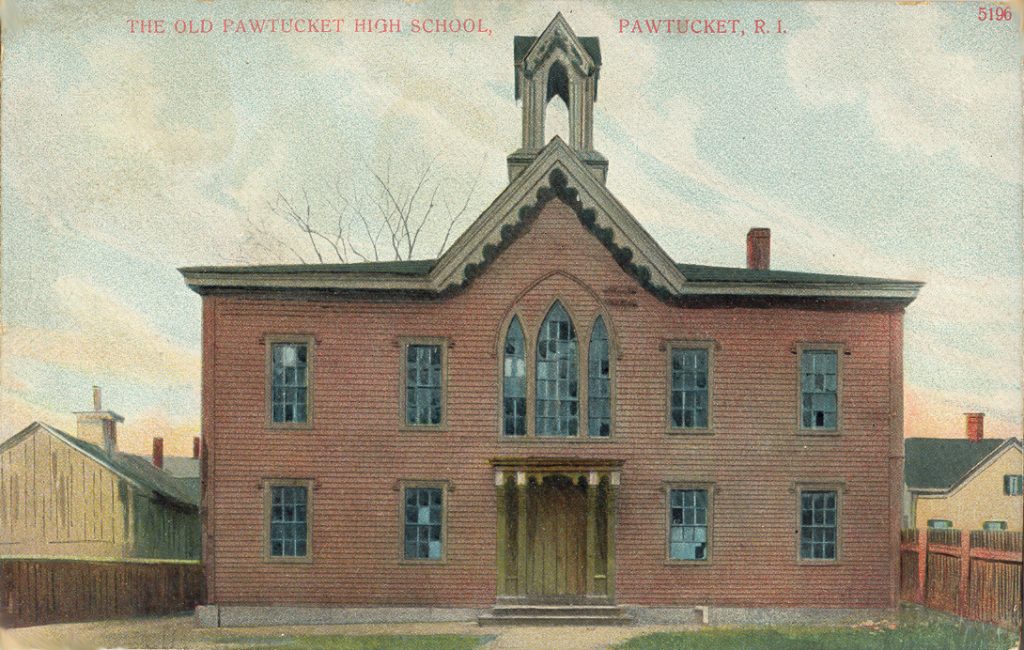Two Rhode Island Postcards

For me, the most fun in collecting postcards is finding a dealer you have never met before. Is it the adventure or mystery of searching a completely different inventory? I think so!!! Such was the case when I bought these cards at the King Hill Books & Old Postcards Store in Kingston, Rhode Island. The Butterfly Factory card has a special charm about it because of the message, but I will tend to the message later. First let’s discover the history of the building.

The Butterfly Factory was built in 1811 along the Moshassuck River by Stephen H. Smith. The structure first served as a cotton mill and bleachery, but was later converted to a print-works that employed most of the town’s working residents. The factory received its name from the two large pieces of stone that are part of the east wall and seem to portray a butterfly silhouette – clearly seen on the postcard between the second-floor windows.
Local historian, Al Kliberg told me when I called him in August that the Butterfly Factory belfry once held a very important bell. It carried a date of 1563 and is said to have originally hung in an English convent, and later to have been aboard the British frigate Guerriere when that ship was captured by the United States ship Constitution during the War of 1812.
So without our permission, time marches on and in 1950 the property and structure were purchased and renovated. The chimney was demolished and the top floor was removed to transform the building into a single family, one-story home.
Now to the message that caught my attention. The card is postmarked October 24, 1907, and is addressed: Master Richard F. Quimby at the Allen Hospital, East Greenwich, Rhode Island
Dear Richard, To-day is Harriet’s birthday & she received many presents. Your birthday will be next month & you will be home by that time so we can have a good time. From brother Roy
Finding a card addressed to a patient in a hospital always begs a question, so I researched the Crawford Allen Memorial Hospital for Tuberculous Children and found that it opened in July 1907. Their mission was to help children inflicted with tuberculotic affection of the bones and glands. When the hospital opened the facility had a capacity of 40 beds – all of which were free.
The Crawford Allen Hospital was built on property donated by Mrs. Anne Crawford Allen Brown (think of the Brown Family that endowed Brown University in Providence, R.I.), and served as a branch of the Rhode Island Hospital.
In an era when the “we will try anything” mindset seemed to think isolation in cool, salty atmospheres would be the ultimate situation for tuberculosis patients, this hospital was designed to be such a sea-side facility – only the second such hospital in the country. Yet another was built in Rhode Island the following year on Dead Goat Island near Providence. [Ask me if you dare about the name of this island.]
My information came from the Russell Sage Foundation’s report on the Campaign Against Tuberculosis in the United States, including a Directory of Institutions Dealing with Tuberculosis in the United States and Canada, ©1908. Notes appended to each directory entry included many topics. A note with the Allen Hospital entry states that the average weight gain per child in 1907 was six and one-half pounds.
My other discovery at the King Hill Books & Old Postcards Store was this beauty.

Look closely at this postcard. It was never used but it is of German manufacture and has a divided back – assumptions are that it is from between 1907 and 1915.
Most times the circumstance of producing a postcard is to present the best of what you have for the world to see. Historians may take a slightly different tact, but why would anyone want to picture a broken-down, abandoned building with nearly every window broken out on a postcard?
The answer is deceptively simple, but I don’t know what it is. Suggestions?
Might the architect of the building have some historical significance to the town but lost in card caption?